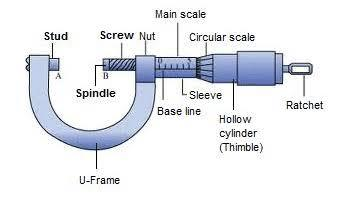
Explain the working principle of screw gauge.
Answer
530.7k+ views
Hint: Screw gauge is an instrument used to measure diameter and thickness of components. It has a calibrated screw on it which is used for accurate measurement of components. It consists of a U-shaped metal frame having a hollow cylinder attached to one end of the frame and on the cylinder parallel to the axis of screw a scale is fixed which is in millimetre. This scale is called pitch scale.
Complete answer:

Screw gauge or Micrometer screw gauge is an instrument which is used to measure thickness or diameter of a component with great accuracy and precision. It is used to measure extremely small dimensions. It belongs to a family of calipers but it can measure much smaller dimensions as compared to vernier calipers.
A screw gauge works on the principle of screw. This screw principle helps to convert smaller distances into larger ones by measuring the rotation of the screw. It amplifies the smaller dimensions and this converts into larger ones. When we rotate the screw, there's a linear movement of the main scale. Then this linear movement helps to calculate diameter or thickness of components.
There are two parameters used in every screw gauge. Those two parameters are pitch and least count of a screw gauge. Pitch is the ratio of distance moved by a screw to the number of rotations given. Least count is the ratio of pitch to total number of divisions on circular scale. Least count of screw gauge is 0.001cm.
Note:
While using a screw gauge, we should take care of the pitch, it’s least count and error. Whether the error is a positive error or negative error. When we bring point A and B together, if the zero mark of the circular scale goes above the main scale line then it is a negative error. When we bring point A and B together, if the zero mark of the circular scale remains below the main scale line then it is a positive error.
Complete answer:

Screw gauge or Micrometer screw gauge is an instrument which is used to measure thickness or diameter of a component with great accuracy and precision. It is used to measure extremely small dimensions. It belongs to a family of calipers but it can measure much smaller dimensions as compared to vernier calipers.
A screw gauge works on the principle of screw. This screw principle helps to convert smaller distances into larger ones by measuring the rotation of the screw. It amplifies the smaller dimensions and this converts into larger ones. When we rotate the screw, there's a linear movement of the main scale. Then this linear movement helps to calculate diameter or thickness of components.
There are two parameters used in every screw gauge. Those two parameters are pitch and least count of a screw gauge. Pitch is the ratio of distance moved by a screw to the number of rotations given. Least count is the ratio of pitch to total number of divisions on circular scale. Least count of screw gauge is 0.001cm.
Note:
While using a screw gauge, we should take care of the pitch, it’s least count and error. Whether the error is a positive error or negative error. When we bring point A and B together, if the zero mark of the circular scale goes above the main scale line then it is a negative error. When we bring point A and B together, if the zero mark of the circular scale remains below the main scale line then it is a positive error.
Recently Updated Pages
Master Class 11 Business Studies: Engaging Questions & Answers for Success

Master Class 11 Computer Science: Engaging Questions & Answers for Success

Master Class 11 Maths: Engaging Questions & Answers for Success

Master Class 11 Economics: Engaging Questions & Answers for Success

Master Class 11 Accountancy: Engaging Questions & Answers for Success

Master Class 11 English: Engaging Questions & Answers for Success

Trending doubts
1 ton equals to A 100 kg B 1000 kg C 10 kg D 10000 class 11 physics CBSE

Difference Between Prokaryotic Cells and Eukaryotic Cells

One Metric ton is equal to kg A 10000 B 1000 C 100 class 11 physics CBSE

What is the opposite of entropy class 11 chemistry CBSE

Proton was discovered by A Thomson B Rutherford C Chadwick class 11 chemistry CBSE

Draw a diagram of nephron and explain its structur class 11 biology CBSE




